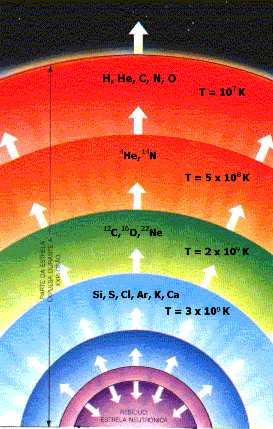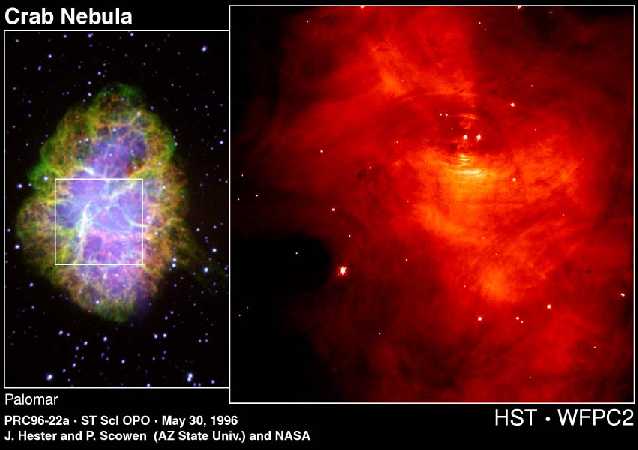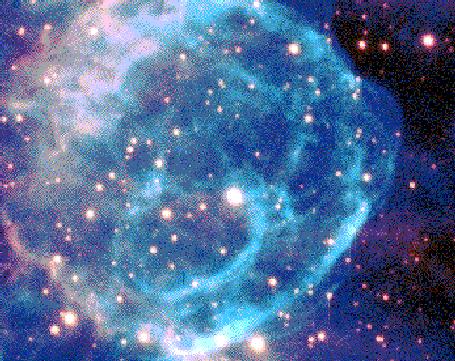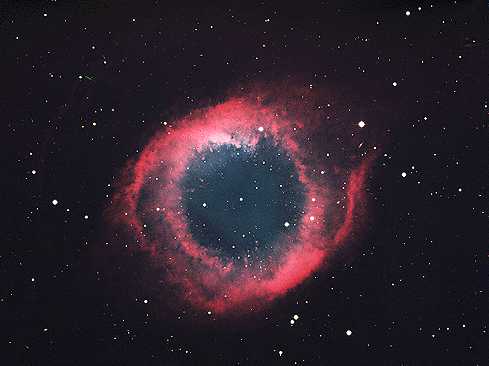The Death
of a Star
The last phase of a star's life begins when in its core there is no more
hydrogen feeding the nuclear reactions that used to keep it balanced up to
then. The star contracts due to the end of its internal activity.
Smaller Stars
In low mass stars, unable to heat up to the
temperatures that are necessary for the helium combustion, what follows next is
simply a slow thermal death, with the remaining body continuing to emit a very
low and decreasing quantity of energy, which was generated during the phase
when hydrogen was still fusing into helium. The fate of these stars will be
ending up as black dwarfs, holding a completely inactive core.
The Fusion of Helium
In large and average sized stars, the contraction provokes a new
rise in their central temperature, up to 100 million ēK (opposing to about 10
to 15 million during the hydrogen burning phase).
The nuclear reactions start again, implying the fusion of the helium
into carbon (at the core) and in the fusion of the hydrogen at the overlaying
layer. It's quite noticeable that the fusion of the helium into carbon just
happens because the mass of 3 helium nuclei corresponds almost exactly to the
mass of 1 excited carbon nucleus, so that those 3 nuclei can be joined into
this new element.
During the period when the helium is fused in the interior of the star,
the outer layers expand, transforming the body into a red giant.
Subsequent Cycles
The cycle is repeated again when, in more massive stars, the carbon
together with the helium take the role of the fuel elements of the fusion,
making the oxygen arise in the interior of the star. The star then starts to
take the shape of a structure comparable to a layered onion, with the lighter
materials being fused in exterior layers and the heavier materials being fused
at the core and surrounding layers.
In a later phase, at the core of even heavier stars, the carbon nuclei
fuse between themselves, giving birth to new elements like neon, sodium,
magnesium, aluminum and silicon. The internal temperature reaches 1 billion ēK
and an increasing quantity of neutrinos is emitted from the interior of the
star.
Afterwards, the star reaches the phase of the neon, oxygen and silicon
fusion, which occur at temperatures between 2 and 5 billion ēK. Meanwhile, the
emission of neutrinos accelerates the emission (loss) of energy, forcing the
centre to contract more strongly and shortening even more the cycles that
succeed one after the other.
At the end of its life, the star produces iron, nickel, copper and zinc,
among other metals. Every element up to the uranium (the heaviest element made
by nature) are produced during this phase.

The layers of a massive star at the
final instants of its life: only the core (in violet) contracts to give birth
to a neutron star; the exterior layers are expelled during the supernova (Michelangelo Miani)
Iron and heavier elements are unable to keep the sequence of nuclear
reactions, because for being fused they take energy instead of giving,
contrarily to what happens with the lighter nuclei. For that reason, when the
centre of the star turns to be predominantly composed by those elements, it
becomes unavoidable the end of the production of the energy that formerly
counteracted the gravity force. The exterior layers fall on the core, becoming
compressed, getting heated to very high temperatures and fueling a violent
nuclear reactions process. The production of energy is so high that the star's
fate can not be any longer delayed: a supernova explodes!

The Crab Nebula: the still fresh
remainings of a supernova that took place in the year 1054 AD
Stellar Blasts and Planetary Nebulae
During the period that precedes the star's death, known as red giant
phase, a expressive portion of the stellar mass can be expelled into the space
through the action of strong stellar winds.
They are noticeable the Wolf-Rayet stars, blue and extremely hot and
bright, whose powerful stellar wind expells the exterior hydrogen layers, thus
uncovering the products of the internal nuclear fusion, which include heavy
elements like the carbon, the nitrogen and the oxygen. There are observations
of a Wolf-Rayet star whose surface temperature reaches 350 000 ēK, or about 7
times the temperature of a common blue giant.

A Wolf-Rayet star (the brightest, at
the centre), surrounded by a bubble of matter ejected by itself (P. Berlind
& P. Challis)
During the red giant phase, the small and average sized stars generate planetary nebulae, or in
other words, they enshroud themselves in ejected matter envelopes, which expand
at about 20 to 30 km / second. 10 000 to 50 000 years later these envelopes become
too rarefied to keep being visible.

The Helix planetary nebula (David
Malin)
Mira Ceti Variables
Red supergiants, like the star Mira Ceti, tend to display expressive
variabilities during this phase and it's often that their luminosity increases
or decreases more than 1000 times during periods that vary between 80 and 700
days.
The variability of these stars is generally considered as a result of succeeding
cycles of expansion and contraction of their diameters. Its periodicity is
inversely proportional to their luminosity. It's also thought that the low
density of the exterior layers of these stars is the determining cause of the
long periods between the luminosity peaks and troughs, but the mechanisms the
determine the pulsation of these stars are unknown.
_